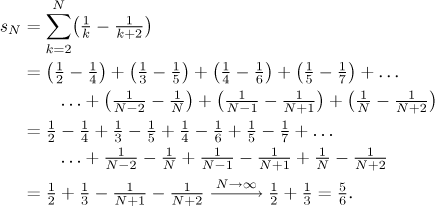
Telescopic series (series whose terms are differences, in a typical case

Note however that more important than the formula itself is the idea behind it, the reduction of a sum to its first and last terms assuming that it collapses in the middle. This allows for a more general approach that is best explained on an example. It will also show that telescopic series can come in disguise.
Example:

This is indeed a telescopic series, although it does not fit into the above pattern. However, when we look at a partial sum, we see that this series also collapses on itself.

Thus

For more examples see Summing up series in Theory - Introduction and this problem in Solved Problems - Summing up series.